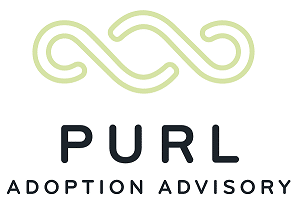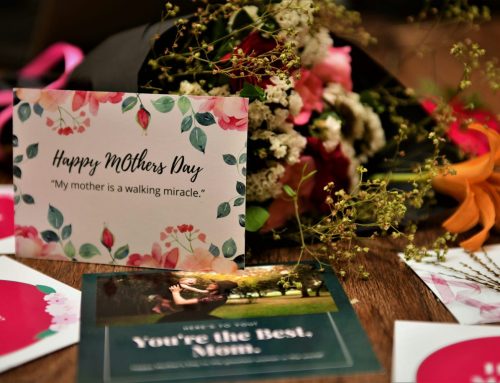Purl’s Director of Graphic Design, Ali Alvidrez, has been helping families adopt through profile and outreach material design for Purl for over four years. Ali is the only member of the Purl Team who is not a member of the adoption triad. However, Ali’s family experience with assisted reproduction is relevant to the impact of embryo donation/adoption on future generations. As Purl expands into guidance in embryo donation/adoption, Ali felt compelled to share her personal experience on the impact of donor conception on her definition of “family’“ today. In this blog post, Ali shares her relationship to a biological half-sister through assisted reproduction.
——-
My phone dings with a text message and a photo of an adorable 5-year-old girl who resembles me, pops up. It is her birthday. She is surrounded by pink balloons and grinning from ear to ear. I am thrilled to receive the photo. I didn’t know her when she was born. In fact, I didn’t know her mom, my biological half-sister, until recently either. But, she is my niece and I love her.
When my dad told me he had donated sperm as a young man who was just starting his career, I was shocked and had a million questions with no answers. Did I have siblings out in the world? Did they live close to me? Will they attend my school? Did they wonder about me? Did they look like me? Would I ever know them? At the time that my father donated his sperm, and even when he later told his kids about this, we did not believe it was possible for donor-conceived siblings to know who their anonymous donor had been. But in recent years, that has changed drastically with the development of DNA analysis methods.
My half sister did not know that the father who raised her was not her biological dad until she did an ancestry DNA test for fun. She told me that she was floored when she did not come up as a DNA relation to her paternal side, so she asked her mom (her father had already passed away). The conversations that followed were long and draining. I can only image her relationships was strained with her mom after such a surprising fact was revealed, but that is likely a story for another day. Her search was only beginning. She uploaded her DNA to 23 and Me and soon connected with a cousin of my dad’s.
For my dad, it was the phone call he had expected for years. He had been told that his donations had been “successful” many times. Therefore, the thought was always on his mind. So honestly, we have been surprised that there haven’t been more biological family members searching for us. Looking toward the future, we can assume, DNA analysis techniques will improve and multiply in the ability to connect people with their own biology.
It still feels unusual to have a sister without having history, and in the beginning I wondered if it was possible for us to connect with any meaning since we were meeting later in life. Each time we have spoken or met in person, I have been filled with curiosity beforehand about how the visit will go. I do love catching up with her though and being an Auntie to her children brings me more joy than I ever could have imagined.
My questions have led me to read numerous articles, blog posts and become part of some private Facebook groups. One resource We are donor Conceived shares the most recent survey results from 2019. 37% of those surveyed found out they were donor conceived from a DNA test. This page also has great resources for sharing information about donor conception with children, something we recommend from a young age. Please also check out Donor Conception Network this is a group for UK conceived but anyone can benefit from the vast informational resources and personal accounts. Lastly, the Donor Sibling Registry is full of useful resources and information for children conceived by assisted reproduction and embryo donation/adoption.
A lot of people are using assisted reproduction to grow their families whether through sperm donation, egg donation or embryo donation/adoption. I am passionate about sharing how important this knowledge is for the child, particularly from a young age. It has become more common to talk to young children about adoption and share some type of openness with their biological families. I hope that in time, the value of these relationships can be seen in more families who have chosen assisted reproduction.
Families are stitched together in many different ways. And I am proud of my father for wanting to help make dreams come true. I still have questions about who else might be out there and if they are thinking about us. I expect more answers to come throughout my lifetime with scientific developments. And, I am grateful to now know my half sister and her family.
Purl’s Director of Graphic Design, Ali Alvidrez, has been helping families adopt through profile and outreach material design for Purl for over four years. Ali is the only member of the Purl Team who is not a member of the adoption triad. However, Ali’s family experience with assisted reproduction is relevant to the impact of embryo donation/adoption on future generations. As Purl expands into guidance in embryo donation/adoption, Ali felt compelled to share her personal experience on the impact of donor conception on her definition of “family’“ today. In this blog post, Ali shares her relationship to a biological half-sister through assisted reproduction.
——-
My phone dings with a text message and a photo of an adorable 5-year-old girl who resembles me, pops up. It is her birthday. She is surrounded by pink balloons and grinning from ear to ear. I am thrilled to receive the photo. I didn’t know her when she was born. In fact, I didn’t know her mom, my biological half-sister, until recently either. But, she is my niece and I love her.
When my dad told me he had donated sperm as a young man who was just starting his career, I was shocked and had a million questions with no answers. Did I have siblings out in the world? Did they live close to me? Will they attend my school? Did they wonder about me? Did they look like me? Would I ever know them? At the time that my father donated his sperm, and even when he later told his kids about this, we did not believe it was possible for donor-conceived siblings to know who their anonymous donor had been. But in recent years, that has changed drastically with the development of DNA analysis methods.
My half sister did not know that the father who raised her was not her biological dad until she did an ancestry DNA test for fun. She told me that she was floored when she did not come up as a DNA relation to her paternal side, so she asked her mom (her father had already passed away). The conversations that followed were long and draining. I can only image her relationships was strained with her mom after such a surprising fact was revealed, but that is likely a story for another day. Her search was only beginning. She uploaded her DNA to 23 and Me and soon connected with a cousin of my dad’s.
For my dad, it was the phone call he had expected for years. He had been told that his donations had been “successful” many times. Therefore, the thought was always on his mind. So honestly, we have been surprised that there haven’t been more biological family members searching for us. Looking toward the future, we can assume, DNA analysis techniques will improve and multiply in the ability to connect people with their own biology.
It still feels unusual to have a sister without having history, and in the beginning I wondered if it was possible for us to connect with any meaning since we were meeting later in life. Each time we have spoken or met in person, I have been filled with curiosity beforehand about how the visit will go. I do love catching up with her though and being an Auntie to her children brings me more joy than I ever could have imagined.
My questions have led me to read numerous articles, blog posts and become part of some private Facebook groups. One resource We are donor Conceived shares the most recent survey results from 2019. 37% of those surveyed found out they were donor conceived from a DNA test. This page also has great resources for sharing information about donor conception with children, something we recommend from a young age. Please also check out Donor Conception Network this is a group for UK conceived but anyone can benefit from the vast informational resources and personal accounts. Lastly, the Donor Sibling Registry is full of useful resources and information for children conceived by assisted reproduction and embryo donation/adoption.
A lot of people are using assisted reproduction to grow their families whether through sperm donation, egg donation or embryo donation/adoption. I am passionate about sharing how important this knowledge is for the child, particularly from a young age. It has become more common to talk to young children about adoption and share some type of openness with their biological families. I hope that in time, the value of these relationships can be seen in more families who have chosen assisted reproduction.
Families are stitched together in many different ways. And I am proud of my father for wanting to help make dreams come true. I still have questions about who else might be out there and if they are thinking about us. I expect more answers to come throughout my lifetime with scientific developments. And, I am grateful to now know my half sister and her family.




